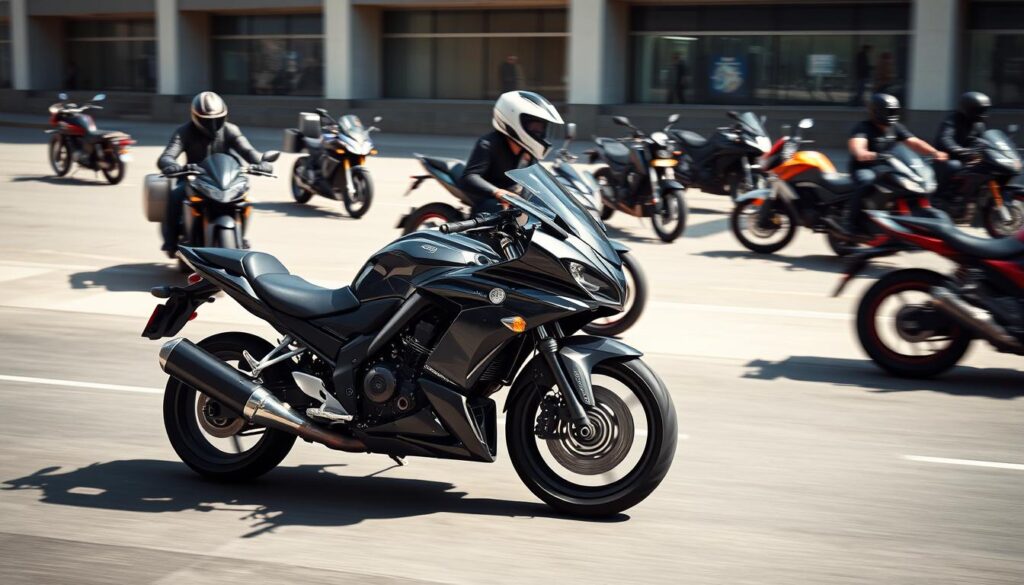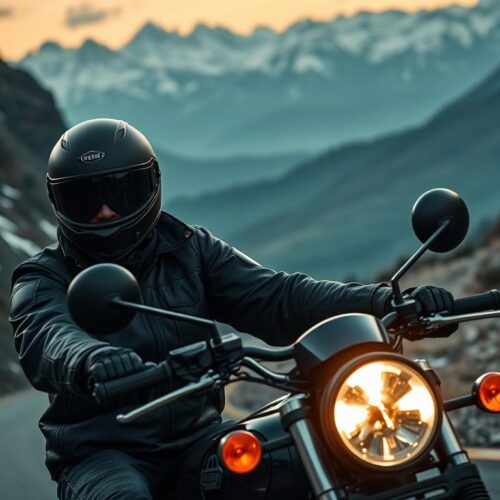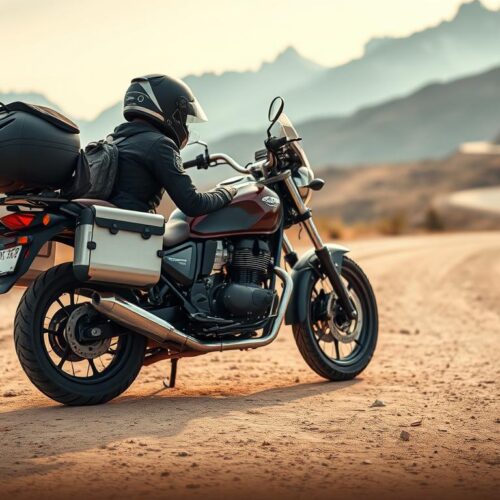For those who love riding, knowing about rider ergonomics is essential. It keeps you safe and makes riding more fun. The right way to sit on your bike boosts comfort and helps avoid back pain. How you position your body, balance your weight, and the design of your bike all affect your ride.
This guide will show you how to sit better on your bike for a great ride. You’ll learn about the best riding posture and how to adjust your bike so it’s best for your body. If you plan to ride with someone else, check out how to keep a good posture by visiting this link.
Understanding Motorcycle Riding Posture
Having the right motorcycle posture is key for safe riding. By keeping a good posture, you improve your control and stability. This is important when dealing with different road conditions and unexpected events. Your body’s position also affects how well you can see, how comfortable you are, and how quickly you can react to dangers.
To get the best motorcycle posture, think about these tips:
- Keep a relaxed grip on the handlebars to avoid unnecessary tension.
- Align your body with the motorcycle, ensuring your knees stay close to the tank for a snug fit.
- Adjust your seat position to prevent fatigue during longer rides.
- Maintain a straight back to promote better weight distribution.
By focusing on these tips, you’ll ride better and more safely. Making sure your motorcycle posture is right can prevent soreness and even accidents. This lets you enjoy riding with more confidence.
Anatomy of Proper Riding Posture
Understanding how to sit right on a motorcycle is key for every rider. The way you position your body has a big impact on how well you ride and stay safe. One of the main things is to keep your spine straight but relaxed, helping with balance and control. This also lowers the chance of getting hurt and helps you ride longer without getting tired.
It’s important to keep your shoulders loose. If they’re tense, you’ll get tired and uncomfortable, making it harder to steer. How you place your hands, arms, and legs also matters a lot for a good riding posture. With your hands in the right spot on the handlebars, turning becomes smoother and reacting to the road easier.
The following table summarizes the vital components of riding posture:
| Posture Element | Importance | Impact on Riding |
|---|---|---|
| Neutral Spine | Prevents strain | Enhances balance and control |
| Relaxed Shoulders | Reduces fatigue | Improves handling |
| Proper Hand Placement | Ensures comfort | Facilitates smoother steering |
| Arm and Leg Positioning | Supports better control | Allows for absorbing shocks |
Keeping a balanced stance helps you deal with bumps on the road better, making it easier to see ahead. Getting your posture right is super important for a safe and fun trip on your bike.
The Role of Motorcycle Type in Posture
Different motorcycle types greatly influence your riding style and comfort. Each design suits various riders and their preferences. Sportbikes, cruisers, and adventure motorcycles have unique features that affect your posture and ease on the road.
Sportbikes position the rider in a forward-leaning manner with high footpegs. This stance can cause discomfort over long periods for those not used to it. In contrast, cruisers offer a laid-back seating with feet forward. This setup ensures comfort on longer rides and improves stability.
Adventure motorcycles offer a balanced posture for various riding conditions. They come with upright seating for better control and comfort. Choosing the right motorcycle type based on your needs makes buying a bike a smarter decision.
| Motorcycle Type | Posture Style | Comfort Features | Passenger Dynamics |
|---|---|---|---|
| Sportbikes | Aggressive, Lean Forward | Limited comfort on long rides | Less space for passengers |
| Cruisers | Relaxed, Feet-Forward | Excellent comfort for extended journeys | Ample room for passengers |
| Adventure Motorcycles | Upright, Versatile | Good balance of comfort and agility | Accommodates riders and passengers well |

Adjusting Your Motorcycle for Optimal Posture
For the best rides, adjusting your motorcycle to fit your body is key. Work on your bike’s ergonomic setup to boost comfort. Begin with the handlebars; they should be at a good height and angle for easy grip. This helps lessen arm and shoulder strain.
Next, look at the seat. Adjust its height so your feet touch the foot pegs while your knees slightly bend. A well-placed seat distributes your weight evenly, making for smoother rides.
Don’t forget footpeg alignment, as it influences your comfort. Set them so your legs are relaxed but can still control the bike. With these adjustments, you’ll enjoy riding more and feel less tired.
Exercises to Improve Your Riding Posture
Special exercises can make your rides more comfortable and fun. Work on your core strength with activities that focus on key muscles for good riding posture. Adding flexibility exercises can lessen stiffness and better align your body on your bike.
Here are some top exercises:
- Planks: They strengthen your whole core, making you steadier on your bike.
- Bicycle Crunches: These are perfect for working your side muscles and building core power.
- Targeted Stretches: Do stretches for your back, hips, and neck to stay flexible and tension-free.
Doing these exercises regularly not only betters your posture but also makes you more mindful of how you sit as you ride. A stronger core leads to a more stable sitting position, giving you enhanced control and ease during your travels.
Understanding Weight Distribution While Riding
Weight distribution is key to balancing and controlling a motorcycle. It helps you react quickly in different situations. Keep your knees snug against the tank and your feet on the footpegs. This makes you more stable.
Using the right weight distribution techniques helps you move with your bike. This lets you ride better and with more confidence. Getting good at shifting your weight means more control and less tiredness on long rides.

To see how weight distribution affects riding, look at this table. It shows how different strategies work for touring, sport riding, and off-roading:
| Riding Type | Weight Distribution Strategy | Effect on Riding Dynamics |
|---|---|---|
| Touring | Center body weight over the seat | Promotes comfort and stability over long distances |
| Sport Riding | Shift weight forward and lean into turns | Improves cornering agility and responsiveness |
| Off-Road | Stand up and lower your center of gravity | Enhances traction and control over uneven terrain |
Learning and using these weight distribution principles will make you a better rider. It makes riding more fun. Focus on improving your weight distribution skills to get more out of motorcycling.
The Impact of Gear on Riding Posture
The gear you pick is key in shaping how you sit on your bike. Things like jackets, pants, and protective gear must give great comfort and help you keep a good posture while riding. When picking out motorcycle clothes, the right fit and being able to move easily is very important.
Wearing big or heavy gear can make it hard to move. This can lead to a bad posture and discomfort over time.
Choosing high-quality, ergonomic gear can make riding much better. Look for materials and designs that help you stay comfortable and keep a good posture. This is important for safe riding. Being comfortable in your gear helps you keep the right posture, which means less strain on your body.
| Type of Gear | Impact on Posture | Recommended Features |
|---|---|---|
| Jackets | Can restrict shoulder movement | Lightweight materials, ergonomic fit |
| Pants | Affect leg positioning | Stretch fabric, pre-curved design |
| Protective Equipment | Can weigh down and hinder mobility | Light yet durable materials, streamlined designs |
Long Distance Riding and Posture Maintenance
For those who love long-distance riding, keeping a good posture is key. It makes the ride comfortable and helps you endure longer on a motorcycle. Bad posture can make you feel tired and sore, especially on long rides. To avoid these problems, try adding some good habits to your riding routine.
Taking breaks to stretch and move around really helps. This lets you fix your posture and avoid pain. Listen to what your body tells you during the ride. Checking how you’re sitting frequently helps catch any bad posture early.
It’s also crucial to set up your bike so it fits you well. Make sure the seat height and handlebars match your body’s needs. A bike that fits you right helps you keep a good posture and can make your rides last longer.
By following these tips, you can make long rides more fun by keeping pain away. Here’s a quick look at the best ways to keep a good posture on long rides:
| Strategy | Description |
|---|---|
| Regular Breaks | Schedule stops to stretch and realign your body to reduce fatigue. |
| Body Alignment | Frequent self-checks on posture help identify discomfort and correct it. |
| Motorcycle Setup | Adjust the seat and handlebars for optimal comfort based on your unique body structure. |
These steps will help you enjoy long rides more by keeping your posture right. This leads to a much better riding experience over long distances.
Tips for Preventing Posture-Related Discomfort
To avoid discomfort during rides, check and change your riding posture often. Tips for motorcycle riding stress the need for a strong grip on the handlebars. This improves control and comfort on your bike. Also, make sure your bike’s parts, like seat height and handlebars, are set right for your body.
Using ergonomic methods in your routine can help keep a good posture. Add exercises that make your core strong and increase flexibility. These exercises help your posture while riding and get you ready for long trips. They keep pain away. Good posture means a more fun ride.
Make sure to take breaks to stretch and fix your posture on long rides. These breaks reduce muscle tension and let you check your posture. By using these tips, you’ll enjoy riding more and avoid discomfort.




